1. Experimental task 1 use any text editor to enter the 8086 assembler source code task1.asm.
task1.asm
1 assume cs:code, ds:data 2 data segment 3 x db 1, 9, 3 4 len1 equ $ - x ; symbolic constants , $Refers to the offset address of the next data item. In this example, it is 3 5 y dw 1, 9, 3 6 len2 equ $ - y ; symbolic constants , $Refers to the offset address of the next data item. In this example, it is 9 7 data ends 8 code segment 9 start: 10 mov ax, data 11 mov ds, ax 12 mov si, offset x ; Take symbol x Corresponding offset address 0 -> si 13 mov cx, len1 ; From symbol x Number of consecutive byte data items at the beginning -> cx 14 mov ah, 2 15 s1:mov dl, [si] 16 or dl, 30h 17 int 21h 18 mov dl, ' ' 19 int 21h ; Output space 20 inc si 21 loop s1 22 mov ah, 2 23 mov dl, 0ah 24 int 21h ; Line feed 25 mov si, offset y ; Take symbol y Corresponding offset address 3 -> si 26 mov cx, len2/2 ; From symbol y Number of consecutive word data items started -> cx 27 mov ah, 2 28 s2:mov dx, [si] 29 or dl, 30h 30 int 21h 31 mov dl, ' ' 32 int 21h ; Output space 33 add si, 2 34 loop s2 35 mov ah, 4ch 36 int 21h 37 code ends 38 end start
Assemble and link the source program to obtain the executable program task1.exe. After running, combined with the running results and comments, and necessary debug ging:

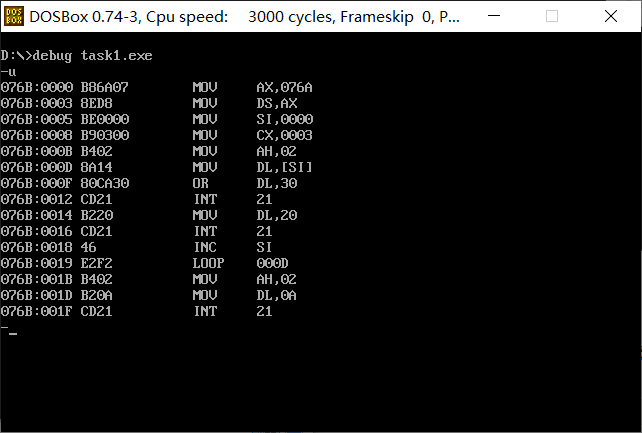
1. Understand the flexible use of operator offset, pseudo instruction equ and predefined symbol $. Through line5, line8 and the data attributes of data items (bytes, words, doublewords, etc.), the number of continuous data items can be calculated easily without manual counting.
Note *: the symbolic constants len1 and len2 do not occupy the memory space of the data segment
2. Answer questions
① line27, when the assembly instruction loop s1 jumps, it jumps according to the displacement. Check the machine code through debug disassembly and analyze the jump displacement? (the displacement value is answered in decimal) from the perspective of the CPU, explain how to calculate the offset address of the instruction after the jump label s1.
The machine code E2F2 of Loop, the displacement is F2 (1111 0010), and the inverse code is 1111 0001, so the original code is 1000 1110 (- 14)
From the perspective of cpu: the loop instruction modifies the ip to point to 000DH, and the ip of the next instruction of the loop instruction is 001BH, then the displacement is 0DH-1BH=13-27=-14
② line44. When the assembly instruction loop s2 jumps, it jumps according to the displacement. Check the machine code through debug disassembly and analyze the jump displacement? (the displacement value is answered in decimal) from the perspective of the CPU, explain how to calculate the offset address of the instruction after the jump label s2. ③ Attach the disassembly screenshot of debugging observation in debug during the above analysis
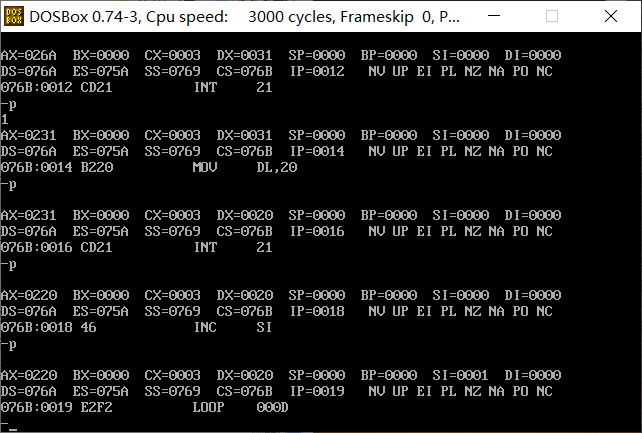
2. Experimental task 2 use any text editor to enter the 8086 assembler source code task2.asm.
task2.asm
1 assume cs:code, ds:data 2 3 data segment 4 dw 200h, 0h, 230h, 0h 5 data ends 6 7 stack segment 8 db 16 dup(0) 9 stack ends 10 11 code segment 12 start: 13 mov ax, data 14 mov ds, ax 15 16 mov word ptr ds:[0], offset s1 17 mov word ptr ds:[2], offset s2 18 mov ds:[4], cs 19 20 mov ax, stack 21 mov ss, ax 22 mov sp, 16 23 24 call word ptr ds:[0] 25 s1: pop ax 26 27 call dword ptr ds:[2] 28 s2: pop bx 29 pop cx 30 31 mov ah, 4ch 32 int 21h 33 code ends 34 end start
① According to the jump principle of call instruction, it is theoretically analyzed that before the program is executed to exit (line31), register (ax) =0021h and register (bx) =0026h Register (cx) = 076ch
② Assemble and link the source program to get the executable program task2.exe. Use debug to observe and verify whether the debugging results are consistent with the theoretical analysis results.
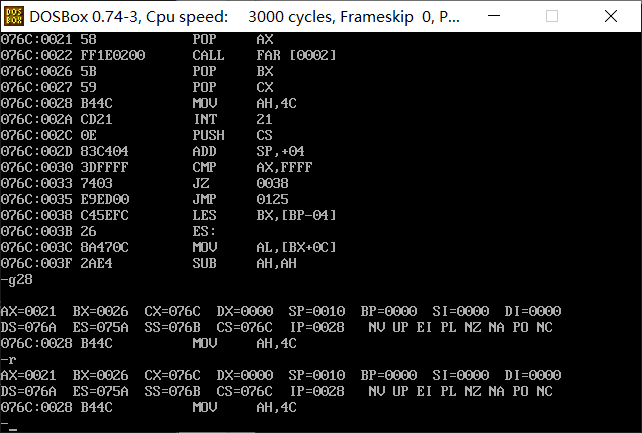
3. Experiment task 3 is for 8086 CPU. The known logic segment is defined as follows:
1 data segment 2 x db 99, 72, 85, 63, 89, 97, 55 3 len equ $- x 4 data ends
Write the 8086 assembly source program task3.asm to output this group of continuous data in the data section in decimal form on the screen, and the data is separated by spaces.
requirement:
Write subroutine printNumber
Function: output a two digit number in decimal form
Entry parameter: register ax (data to be output -- > ax)
Exit parameter: printSpace without writing subroutine
Function: print a space
Entry parameters: None
Outlet parameters: None
In the main code, the addressing mode and loop are comprehensively applied, and printNumber and printSpace are called to realize the subject requirements.
When correctly written, the expected test results are as follows:
1 assume cs:code, ds:data 2 3 data segment 4 x db 99, 72, 85, 63, 89, 97, 55 5 len equ $- x 6 data ends 7 8 code segment 9 start: 10 mov ax,data 11 mov ds,ax 12 mov si,offset x 13 mov cx,len 14 mov bl,0ah 15 s1: mov al,[si] 16 mov ah,0 17 call printNumber 18 call printSpace 19 inc si 20 loop s1 21 22 mov ah, 4ch 23 int 21h 24 printNumber: 25 ;Divide by 10 and take the mold 26 div bl 27 mov bh,ah 28 mov dl,al 29 ;turn ASCII code 30 or dl,30h 31 mov ah,2 32 int 21h 33 mov dl,bh 34 or dl,30h 35 int 21h 36 ret 37 printSpace: 38 mov ah,2 39 mov dl, ' ' 40 int 21h 41 ret 42 43 code ends 44 end start
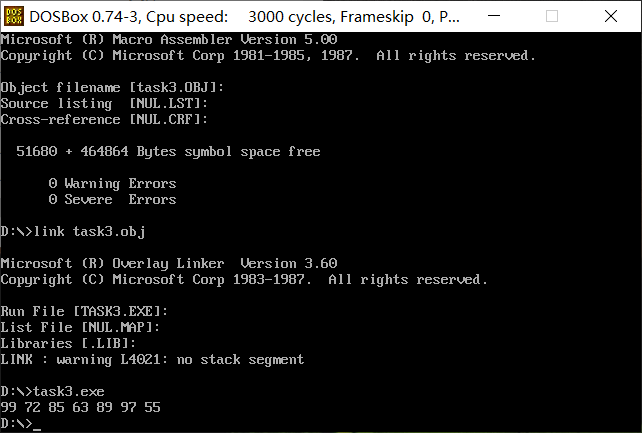
4. Experiment task 4 is for 8086 CPU. The known logic segment is defined as follows:
1 ; Function: output single character 2 mov ah, 2 3 mov dl, ×× ; ××Is the character to be output, or its ASCⅡCode value 4 int 21h
1 assume cs:code, ds:data 2 3 data segment 4 str db 'try' 5 len equ $ - str 6 data ends 7 8 code segment 9 start: 10 mov ax,data 11 mov ds,ax 12 13 mov cx,len 14 mov si,offset str 15 mov bh,0 16 mov bl,2 17 call printStr 18 19 mov cx,len 20 mov si,offset str 21 mov bh,24 22 mov bl,4 23 call printStr 24 25 mov ah,4ch 26 int 21h 27 printStr: 28 ;Address of segment corresponding to calculation line 29 mov al,0ah 30 mul bh 31 add ax,0b800h 32 mov es,ax 33 34 mov di,si 35 ;Write to video memory 36 s: mov al,ds:[si] 37 mov ah,bl 38 mov es:[di],ax 39 inc si 40 add di,2 41 loop s 42 ret 43 code ends 44 end start

5. Experiment task 5 is for 8086 CPU. For 8086 CPU, the known logic segment is defined as follows:
1 data segment 2 stu_no db '20498329042' 3 len = $ - stu_no 4 data ends
At 80 × In 25 color character mode, the student number is displayed in the middle of the last line of the screen. It is required that the student number and broken lines on both sides of the output window are displayed in white foreground.
1 assume cs:code,ds:data 2 3 data segment 4 stu_no db '201983290376' 5 len = $-stu_no 6 data ends 7 stack segment 8 dw 2 dup(0) 9 stack ends 10 code segment 11 start: 12 ;White characters on blue background 13 mov bl,00010111b 14 mov bh,' ' 15 mov ax,stack 16 mov ss,ax 17 mov sp,2 18 mov ax,data 19 mov ds,ax 20 mov si,0 21 mov cx,25 22 ;Fill background 23 fillBg: 24 mov al,0ah 25 mov dx,si 26 mul dl 27 add ax,0b800h 28 mov es,ax 29 push cx 30 push si 31 mov cx,050h 32 mov si,1 33 ;Inner loop, fill one line 34 fillBgLine: 35 mov es:[si],bx 36 add si,2 37 loop fillBgLine 38 39 pop si 40 pop cx 41 inc si 42 loop fillBg 43 44 ;Process last line 45 mov dx,028h 46 sub dx,len/2 ;2dx Is the number of polylines 47 mov si,0 48 ;Output front polyline 49 call printLine 50 ;Output student number 51 mov cx,len 52 mov di,offset stu_no 53 no: mov al,ds:[di] 54 mov es:[si],al 55 inc di 56 add si,2 57 loop no 58 call printLine 59 60 mov ah,4ch 61 int 21h 62 printLine: 63 mov cx,dx 64 s: mov es:[si],byte ptr '-' 65 add si,2 66 loop s 67 ret 68 69 code ends 70 end start
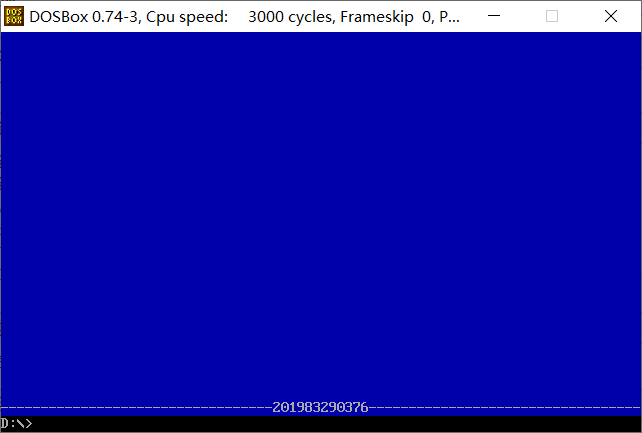
summary
1. Have a deeper understanding of the jump principle of transfer instruction
2. Master the method of subroutine programming with call and ret instructions